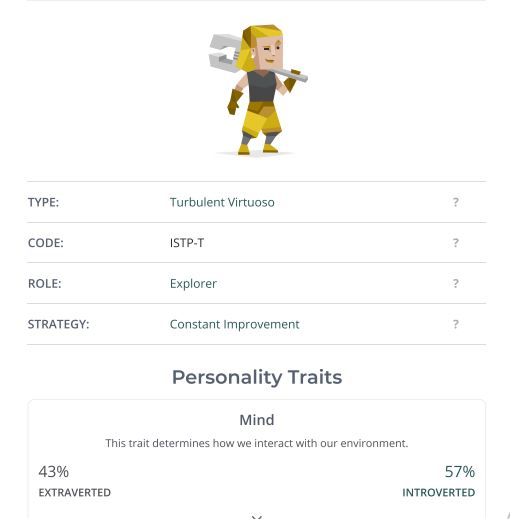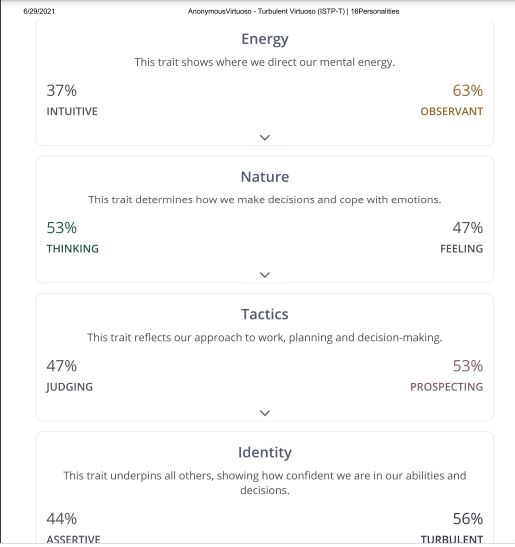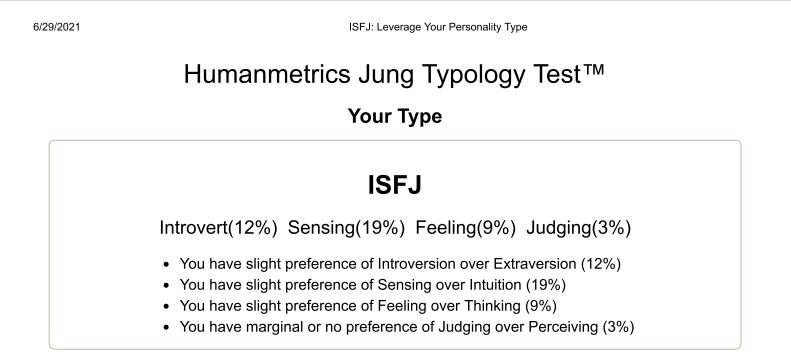Conflict avoidance is one behavior that tends to undermine my leadership performance. Its prevention is an intentional way of leading, applied to improve the performance and outcome of leadership. However, the causalities between conflict prevention and good governance are uncertain. Therefore, the deliberate implementation of avoiding conflict as an aspect of effective management implies that entrusted leaders act as if they support their teams in crises. This may not mean delaying or preventing a conflict forever (Schein and Schein, 2018, p. 16). A leadership approach could involve more intentional conflict prevention than other types, perhaps contingency governance, where new variations or styles have been implemented in different situations. The transition style is another extent to which a leader somehow does not require the approval of his adherents, mainly so that he or she can purposely avoid conflict. According to my ISJF results shown in Appendix 2, characteristics of various personality styles may apply to me. Thus, while there is a division between creativity and a healthful environment in which disagreements are rare and conflict-preventing occurrences, many people instinctively avoid them.
The best option of attitude is often not engaging in a conflict. Sometimes the best approach is to stand in a battle to maintain a necessary relationship or cause. Dispute resolution has become an issue where a standstill jeopardizes the capacity to make a larger bet or merely find the correct thing that involves risks alone. This obstruction to participation is among the fundamental problems that a figurehead can stop people from resolving a significant issue. When individuals avoid the slightest discord, they compromise their real feelings and store frustration that can affect their health negatively (Park and Nawakitphaitoon, 2018, p. 13). Bottling one’s emotions may boost mortality risks, such as mortality, as disturbing emotions can also lead to hopelessness or depression. While avoidance of problems sometimes appears to be the best solution for dealing with conflict, it damages the interaction of the people affected by those within their social circles (McKibben, 2017, p. 2). As seen in Appendix 1, I am an introvert; thus, my character makes me like avoiding conflicts with those within my social cloud, a threat to y goal of transforming into a celebrated leader.
Exploration of The Literature
Throughout all kinds of situations, conflicts may occur among individuals or in groups. Given the wide range of differences between people, a lack of competition can indicate weak interaction. A disagreement should not be seen as good or bad but as a necessity for fostering meaningful relations between individuals and groups. It determines if it is constructive or devastating by the means or how the dispute is handled. However, conflict could also destroy relationships and cause adverse outcomes, creating positive prospects and advancing towards a mutual objective (Kerns, 2016, p. 18). The ability to deal with differences is an underrepresented aspect not frequently mentioned in leadership. Conflict resolution is competence leaders need to use to promote a positive working environment when necessary.
An investigation using the Myers-Briggs Type Indicator® revealed that introverts are people who constantly try to avoid conflict and are more inclined to feel a favor rather than a thought preference. Introverts are more likely to notice a situation and “hold” their thoughts and feelings until they know where they are and are compelled to act. They are less likely to react instinctively to or incite conflict. Feeling-oriented introductions will be susceptible to the effects on the involved parties of the disagreement. They will probably make decisions on this basis instead of based on reason or evidence (Yang and Li, 2017, p. 2). Conflict-prevention introductions may be considered “passive” or “weak, but have the edge of not participating in a confrontation until the predicament is correct and ready.
Conflict resolution should be recognized as an ability that leaders must give preference to learning and understanding. The failure of a supervisor to address strife leads to a bad outcome and can undermine the leadership’s credibility. If leaders can establish a co-operation atmosphere, encourage teamwork, and show their value system, all organizations will likely adopt this value system. Most people want a conflict to exist for various reasons (Park and Nawakitphaitoon, 2018, p. 4). Such people want to be accepted and want to have stability in their lives. Sadly, significant executives and leaders conduct themselves without tackling a difference as it occurs on the job. Indeed, they put their groups at serious risk if they decide to prevent friction at any cost.
From the standpoint of development, someone who consistently avoids conflicts is likely to encounter events in life that reinforce the notion that disagreements are bad. There may have been punishments for disputes and a feeling of fear of retribution. Family values that discourage arguments or display disagreement can also affect individuals’ willingness and ability to affirm themselves when a different perspective exists. The responsibility or leadership role of people in a household or organization can impact their courage to speak up (Mercer-Mapstone et al., 2017, p. 6). Furthermore, despite progress in this respect, stereotypes about the role of sex continue to make certain women less willing to face men with differing beliefs.
Persons who consider conflict to be harmful, dangerous or necessary, are likely to prevent it physically and mentally when possible. Otherwise, youngsters who have opportunities to evaluate options and share their opinions and feelings productively learn that it can be health-conscious and rewarding to recognize the difference. The growth provides both social and practical benefits, demonstrating its significance. The courage to deal with stress and fear inherent in conflict dynamics comes from experiences that encourage and support the management of conflicts (Yang and Li, 2017, p. 1). Evaluating when and how to deal with differences leads to improved decision-making and more constructive results if integrated into the family and even organizational life. Apprenticeships are an effective tool for improving when choosing the actions to be taken in conflict resolution. It can create unnecessary problems to challenge other parties’ decisions consistently, but particular disputes can generate benefits if appropriately handled.
The leader’s role in conflict management can influence how they are settled on the job or institution. Leaders spend approximately 24% of everyone’s time resolving issues, but their leadership style does not affect the strategy for conflict resolution. Guidance and a vision of dispute resolution can be provided to leaders using dispute skills. A common feature of representatives is that they can build teams that work together to assist with the organization’s tone. They need to help resolve conflicts effectively by managing disputes. A standard error in problem-solving is to avoid conflict resolution altogether. Preventing a disagreement may be less stressful for a while, but it leads to more problems. Stress rises, and discontent increases when disputes are not effectively and promptly addressed (Flores, Jiang and Manz, 2018, p. 426). This move could lead to conflict exaggeration, calling for the need to invest in the solution and resolve disputes in an affirmative manner, which is much healthier.
Evidence-Based Techniques for Dealing the Behavior
From a performance viewpoint, it is evident that conflicts at the workplace must be tackled head-on. Employees must feel cherished and listed, and companies should have a stubborn battle. The situation must be resolved to utilize an open and frank sharing of ideas. Co-workers must be able to give their concerns and thoughts in the devotion of development and problem-solving without the paranoia of being put on the accordance of signature. This approach is an area in which leaders can intervene and manage conflicts. It is crucial for providing the HR department service in a quiet, relaxed environment to solve urgent concerns (Zhang and Wei, 2017, p. 796). Thus, the following strategies will play a crucial role in resolving the issue associated with avoiding conflicts in a workplace or household:
Engaging in regular and authentic conversation focuses on improving many aspects of your working life can help reduce the chances of conflict avoidance. This strategy can help as regards resolution in terms of conflict. Managers must be urged to staff their figurehead, their families more confident and capable of addressing difficulties. Managers must be motivated to meet with their staff regularly (Schein and Schein, 2018, p. 13). The execution of regular inspections and enhancements will contribute to the development of the immediate, fluid communication cultures and the development of the demonstrates to all those involved who hear, value, and respect their opinions (Goleman, 2021, p. 12). Connecting with innovative ideas and those that can help to bring about change will help promote successful leadership.
Reframing confrontation is another way to help address conflict avoidance. It is a rewording or re-establishment technique that is more constructive than what opposing parties say. This development supports customers to clarify the importance of the customer to them in a conflict situation. Conflict resolution means speaking for oneself and able to communicate when enraged or frustrated. Scholars say that this is a question of ensuring that issue matters are addressed to prevent them from ever doing it again (Quebec Fuentes and Bloom, 2017, p. 2). A competent reframe will redirect your conversation to show what the speaker wants from a fascination with the negative. It is always more necessary for people to debate their demands than to allow them to get involved. As an added advantage, reframing assists all conflicting parties to accept an impartial and problem-solving outlook. If parties become receptive or if they are not, the practice of reframing could happen quickly. Parties, in many instances, do not know how the conflict is. The parties feel encouraged to pursue the cause of their disagreements in the presence of a negotiator.
Reflecting on the disagreements is essential to determine the cause and consider the words to use during the confrontation. Emotions can make navigating with a level head and a clean heart difficult if there is friction in a partnership or organization. Leaders must give themselves time to solve everything. Members of society face challenges when their fundamental values are threatened by a situation (Mercer-Mapstone et al., 2017, p. 6). It helps one understand why they feel at some instances instead of responding out of defense or pain. Individuals must spend time and space on themselves to understand what it is all about. However, if this is clear, they will be freer to respond effectively, truthfully, and courageously.
Conclusion
Conflict prevention is among the main topics of counseling for couples. Its handover occurs when one affiliate tries to avoid disagreements, so the relationship is protected from further escalation. Sometimes it makes perfect sense to retreat or to distance oneself to prevent war. This pattern even erodes interaction because individuals do not feel secure anymore when they are retiring from communication. In addition, they inevitably begin a row within themselves if they continue to avoid disputes to save tranquility in their connections. Conflict prevention refers to ways to resolve a discrepancy or problem by not addressing it intentionally. Ignoring the problem is among the most popular ways to prevent conflict. One does not have to cope with the result by ignoring the issue and not debating it. The case has shifted to a different method of avoiding conflict. If a person talks about something that bothers their partner, they will begin to talk about something that concerns them.
Conflict is inevitable, irrespective of the environment and the persons involved. To achieve a positive outcome in a row, stakeholders must acknowledge that a dispute is necessary. Conflict studies enable people to understand them more adequately and contribute to improved results (Park and Nawakitphaitoon, 2018, p. 2). Conflict management could be a productive ability that makes representatives in their organizations, eventually leading to efficient productivity to establishing healthy relationships. Therefore, conflict resolution must be part of the toolset of a leader and implemented in an organization if a disagreement occurs. If the issue is not resolved promptly, the team’s morale can be affected, but more significant problems can arise later.
References
Flores, H.R., Jiang, X. and Manz, C.C., 2018. Intra-team conflict: The moderating effect of emotional self-leadership. International Journal of Conflict Management.
Goleman, D., 2021. Leadership: The power of emotional intelligence. More Than Sound LLC.
Kerns, C.D., 2016. High-impact communicating: A key leadership practice. Journal of Applied Business and Economics, 18(5), pp.11-22.
McKibben, L., 2017. Conflict management: Importance and implications. British Journal of Nursing, 26(2), pp.100-103.
Mercer-Mapstone, L. et al., 2017. Idealism, conflict, leadership, and labels: Reflections on co-facilitation as partnership practice. Teaching and Learning Together in Higher Education, 1(21), p.8.
Park, J.Y. and Nawakitphaitoon, K., 2018. The cross‐cultural study of LMX and individual employee voice: The moderating role of conflict avoidance. Human Resource Management Journal, 28(1), pp.14-30.
Quebec Fuentes, S. and Bloom, M., 2017. Reframing a problem: Identifying the sources of conflict in a teacher education course. Educational Action Research, 25(5), pp.687-703.
Schein, E.H. and Schein, P.A., 2018. Humble leadership: The power of relationships, openness, and trust. Berrett-Koehler Publishers.
Yang, I. and Li, M., 2017. Can absent leadership be positive in team conflicts? An examination of leaders’ avoidance behavior in China. International Journal of Conflict Management.
Zhang, Z.X. and Wei, X., 2017. Superficial harmony and conflict avoidance resulting from negative anticipation in the workplace. Management and Organization Review, 13(4), p.795.
Appendices
Appendix 1. MBTI Results of 16 Personalities


Appendix 2. ISFJ: Leverage Your Personality Type Results
